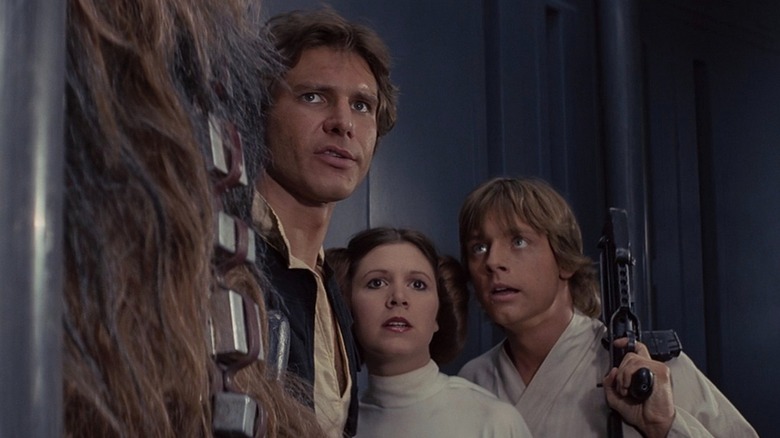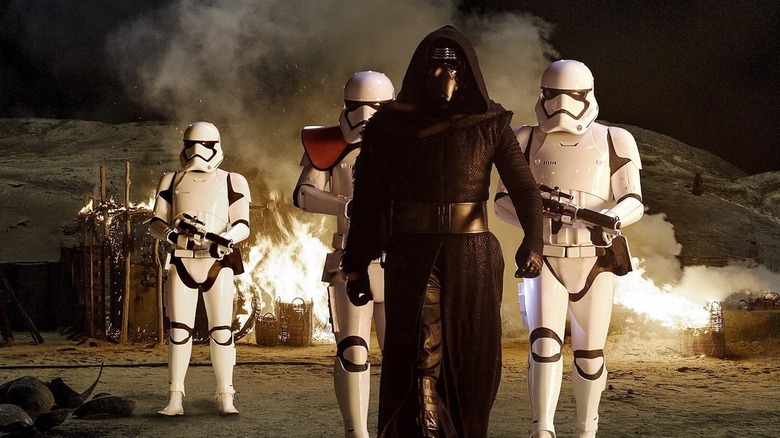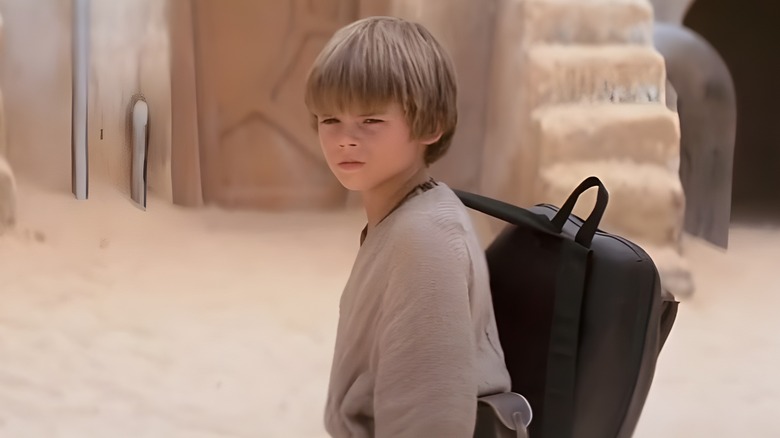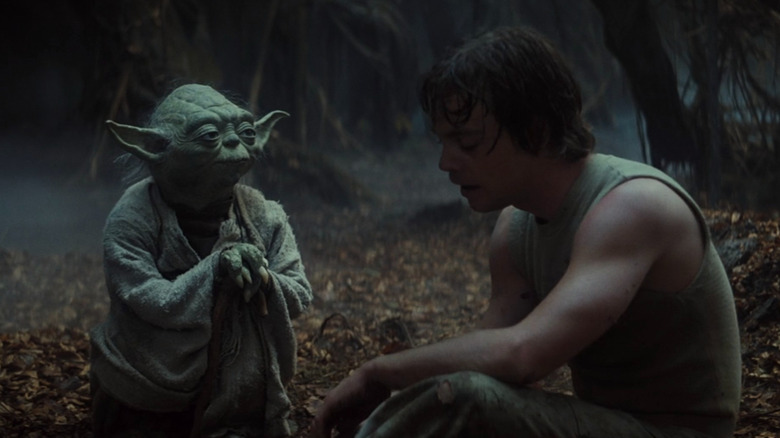The Star Wars Movies In Chronological Order - Does It Really Matter?
In the over 40 years since its release, George Lucas' "Star Wars" film spawned the nine-chapter Skywalker Saga along with two anthology films. From the perspective of newcomers to the franchise, it may seem confusing to know what's the ideal order to watch them. Thankfully, it's not as complex as you might think.
The first released entry was 1977's "Star Wars." In 1981, the film was retroactively renamed "Star Wars: Episode IV — A New Hope," implying that the events of the movie were taking place in the middle of the saga. This change was also translated in the two follow-up entries of the original trilogy, with 1980's "Episode V — The Empire Strikes Back" and 1983's "Episode VI — Return of the Jedi."
The franchise wouldn't return to theaters until 1999 with "Star Wars: Episode I: The Phantom Menace," the first installment of the prequel trilogy that showcased Anakin Skywalker's gradual transformation into Darth Vader. The film was followed up by "Episode II: Attack of the Clones" in 2002 and "Episode III: Revenge of the Sith" in 2005.
Finally, we received the sequel trilogy. This set of films released between 2015 and 2019 includes "Episode VII — The Force Awakens," "Episode VIII – The Last Jedi," and "Episode IX — The Rise of Skywalker." Also under Disney came the two standalone anthology films, "Rogue One: A Star Wars Story" and "Solo: A Star Wars Story," which both occur between the events of "Revenge of the Sith" and "A New Hope."
The good news is that you can watch the "Star Wars" movies in any order you please without being overly confused. But there are things to consider before taking your own light-speed jump into the franchise.
The sequel trilogy might make for an overwhelming introduction
It's probably not best to kick off your "Star Wars" marathon with the sequel trilogy. While these entries have helped catapult the franchise into the billions, with "The Force Awakens" ranking as the fifth highest-grossing film of all time as of this writing, they may be a bit much for first-time fans to take in.
Set three decades after the events of "Return of the Jedi," the latest addition to the saga sees a new band of rebels known as the Resistance go up against the tyrannical New Order led by the villainous Kylo Ren (Adam Driver). Leading these heroes is the force-sensitive Rey (Daisy Ridley), former stormtrooper Finn (John Boyega), and fighter pilot Poe Dameron (Oscar Isaac). Along with these new faces, the sequel trilogy also sees the return of several original trilogy characters such as Luke Skywalker (Mark Hamill), Han Solo (Harrison Ford), and Leia Organa (Carrie Fisher) in new roles.
While the sequel trilogy, like the two that preceded it, primarily focuses on a new set of characters, fully understanding the roles of some of the returning players and world-building elements requires at least a basic understanding of prior "Star Wars" lore. However, this sentiment is mostly reserved for the original trilogy, as the sequels don't go very far in referencing the prequels. It's not impossible to jump headfirst into this set of "Star Wars" films, but just be warned that you may have to play some catch-up in the process.
Starting with the prequels gives you a better appreciation for Darth Vader's story
According to George Lucas himself, the best place to start with the franchise is the prequel trilogy. For many fans growing up in the late 1990s and early 2000s, these entries were their introduction to the galaxy far, far away. With their revolutionary use of CGI and beloved set of characters, it's easy to see how these installments became the favorites of a new generation of "Star Wars" fans.
This collection of sci-fi epics chronicles the rise and fall of Anakin Skywalker from a promising Jedi knight to the future Sith Lord Darth Vader. He begins life as a child (Jake Lloyd) who is prophesied to be the Chosen One taken under the tutelage of Jedi knights Qui-Gon Jinn (Liam Neeson) and Obi-Wan Kenobi (Ewan McGregor). As time goes on, Anakin grows into a young adult (Hayden Christensen) who proves to be a skilled user of the Force. However, his love for the former queen Padmé Amidala (Natalie Portman) allows Anakin to be manipulated by the devious Darth Sidious (Ian McDiarmid), who gradually tempts the young Jedi to join the Dark Side while also corrupting the Galactic Republic.
While these movies are not without their flaws, they provide new viewers with a well-rounded view of how Darth Vader came to be. Rather than being a typical hero journey, the prequels paint themselves as a tragedy of what can happen to a great mind when befallen by deceit. There's also no shortage of spinoff material from this trilogy to choose from, most notably the acclaimed animated series "Star Wars: The Clone Wars."
The original trilogy is the best introduction to the franchise
There's ultimately no right or wrong way to start the "Star Wars" saga. But as the saying goes, the best place to start is at the beginning, and there are few beginnings as impactful to the cinematic landscape today as the original "Star Wars" trilogy.
The three-part space opera follows the adventures of former farm boy Luke Skywalker who, along with newfound friends Han Solo, Princess Leia, Chewbacca (Peter Mayhew), C-3PO (Anthony Daniels), and R2D2 (Kenny Baker), joins the Rebel Alliance in the galaxy's ongoing war against the Galactic Empire led by Darth Vader and Emperor Palpatine. Along the way, Luke is taught the ways of the Force with the aid of great masters such as Obi-Wan Kenobi (Alec Guinness) and Yoda (voiced by Frank Oz).
Chronologically, the original trilogy takes place in the middle of the Skywalker Saga. But as these movies came out long before any additional material could provide extra context, they do a superb job at introducing audiences to the world in a way that is easy to follow and still full of mystery. Ultimately, no other "Star Wars" project — or any special effects-driven blockbuster for that matter– would exist without this set of awe-inspiring adventures. For their influence on the next four decades of filmmaking alone, the original trilogy deserves your time above all else.



